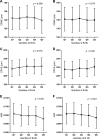Hemoglobin levels are associated with retinal vascular caliber in a middle-aged birth cohort
- PMID: 38643302
- PMCID: PMC11032340
- DOI: 10.1038/s41598-024-59688-y
Hemoglobin levels are associated with retinal vascular caliber in a middle-aged birth cohort
Abstract
Vascular and neural structures of the retina can be visualized non-invasively and used to predict ocular and systemic pathologies. We set out to evaluate the association of hemoglobin (Hb) levels within the national reference interval with retinal vascular caliber, optical coherence tomography (OCT) and visual field (VF) parameters in the Northern Finland 1966 Birth Cohort (n = 2319, 42.1% male, average age 47 years). The studied parameters were evaluated in Hb quintiles and multivariable linear regression models. The lowest Hb quintile of both sexes presented the narrowest central retinal vein equivalent (CRVE) and the healthiest cardiometabolic profile compared to the other Hb quintiles. In the regression models, CRVE associated positively with Hb levels in both sexes, (Bmales = 0.068 [0.001; 0.135], Bfemales = 0.087 [0.033; 0.140]), after being adjusted for key cardiometabolic and inflammatory parameters, smoking status, and fellow vessel caliber. No statistically significant associations of Hb levels with central retinal artery equivalent, OCT or VF parameters were detected. In conclusion, Hb levels were positively and specifically associated with CRVE, indicating that Hb levels are an independent factor affecting CRVE and the effect is in parallel with established risk factors for cardiometabolic diseases.
© 2024. The Author(s).
Conflict of interest statement
The authors declare no competing interests.
Figures




